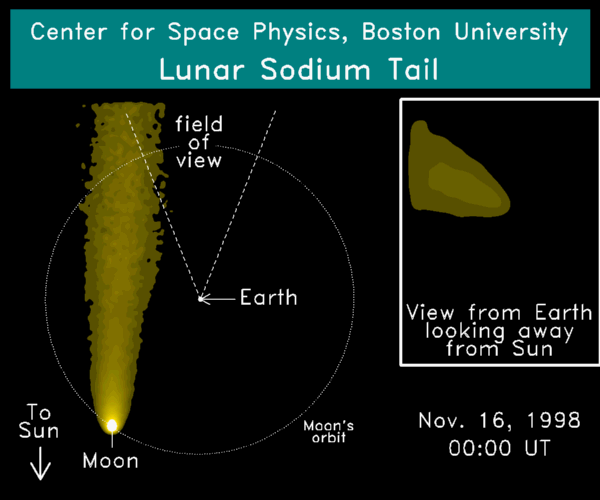Lunar Sodium Exosphere
After Drew Potter and Tom Morgan used ground-based telescopes to observe Mercury's exosphere in the 1980's, they turned their attention Moonward and showed that the Moon also has sodium in its thin exosphere. Coronagraphs and sprectograph studies followed, but then something unexpected happened. In 1998, during an observing campaign at the McDonald Observatory to study the effects of the Leonid meteor shower on the terrestrial (mesospheric) sodium layer, a fortuitous discovery was made of a faint spot of sodium emission near the anti-Sun/Moon direction. The feature was determined to be the escaping lunar atmosphere, but at an vast distance >400,000 km. Radiation pressure pushes the Moon's escaping atmosphere into a comet-like tail. During a New Moon alignment, as this gas cloud passes by the Earth, our gravity alters the atoms' trajectories and focuses the diffuse cloud into a dense column, analagous to a lens. Back scatter from the focal point is the "Moon Spot" and here is a more complete description of this cool phenomenon. Jody Wilson coded up this simulation of the effect:

More recently, our research group here has been trying to use the Moon Spot to infer some physical properties of the lunar exosphere. This undertaking gets a bit complicated due to viewing geometry. The shape/location/brightness of the Moon Spot differs depending on the observer's location. An example below shows an portion of the all-sky sodium camera at Mt John New Zealand blinked with a concurrent observation at McDonald Observatory. This stereo perspective highlights differences due solely to viewing geometry.
Viewing effects also have the consequence that the Moon Spot changes over the course of a few hours. The video below was taken by Jeff Baumgarnder with a 10cm coronagraph of his own design at McDonald Observatory. The observations were made just a few hours after a solar eclipse when the Moon near the on the ecliptic plane, as traced by the white line. Such alignment gave a very bright Moon Spot at lower left. Jupiter's sodium nebula due to Io's volcanic outgassing is also seen at the center of this field of view. April 9th 2005 was also near Jovian opposition, offering a rare timing in which both sodium gas clouds were observable in the same 7.5 degree field of view! Some thin high cloud cover causes more scattered light, and that causes the flashing effect around Jupiter---ignore all that bit. The only true morphology here is in the Moon Spot at lower left. It's due both to the Earth-Moon system geometry and to the Earth's rotation changing the viewer's perspective via parallax.
Between NASA's LADEE misson, these Moon Spot observations, and new RIPS spectra that give an altitude/linewidth profile near the lunar surface, there's a lot of new data filling up hard drives. Trying to make sense of it all self-consistently will pose a challenge for models, but we'll certainly learn things in the process, so that's the plan from here.